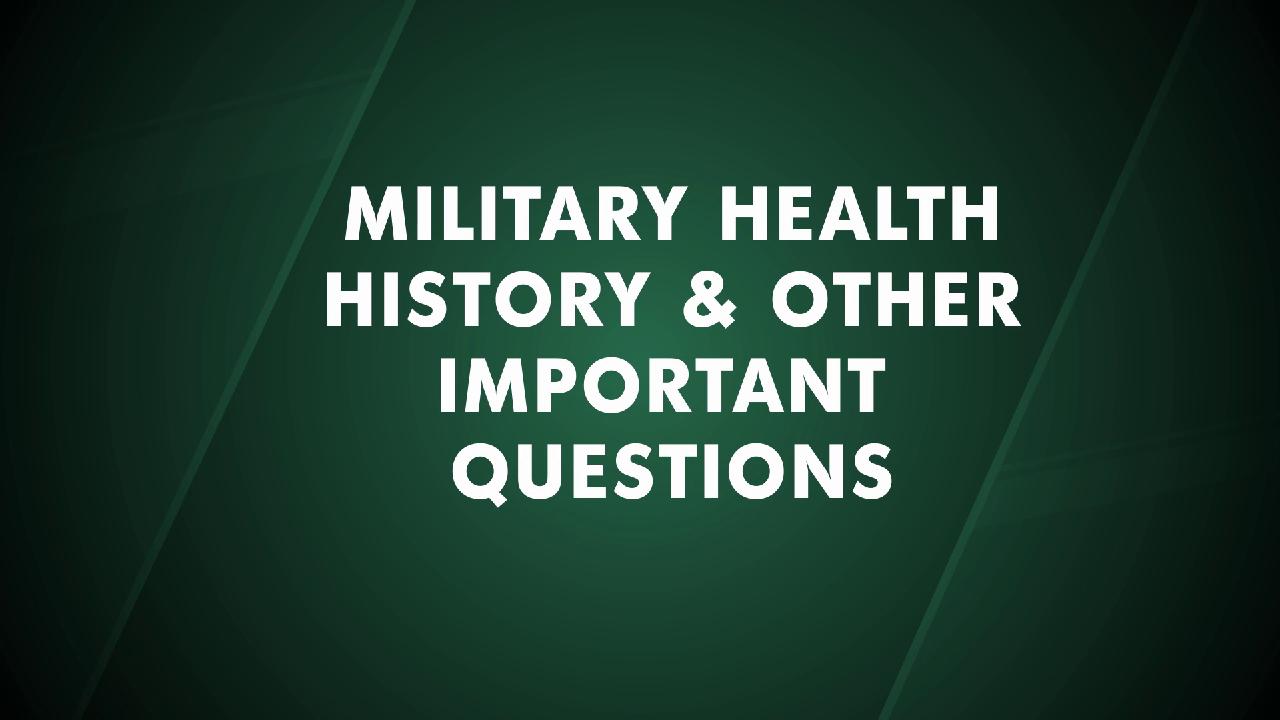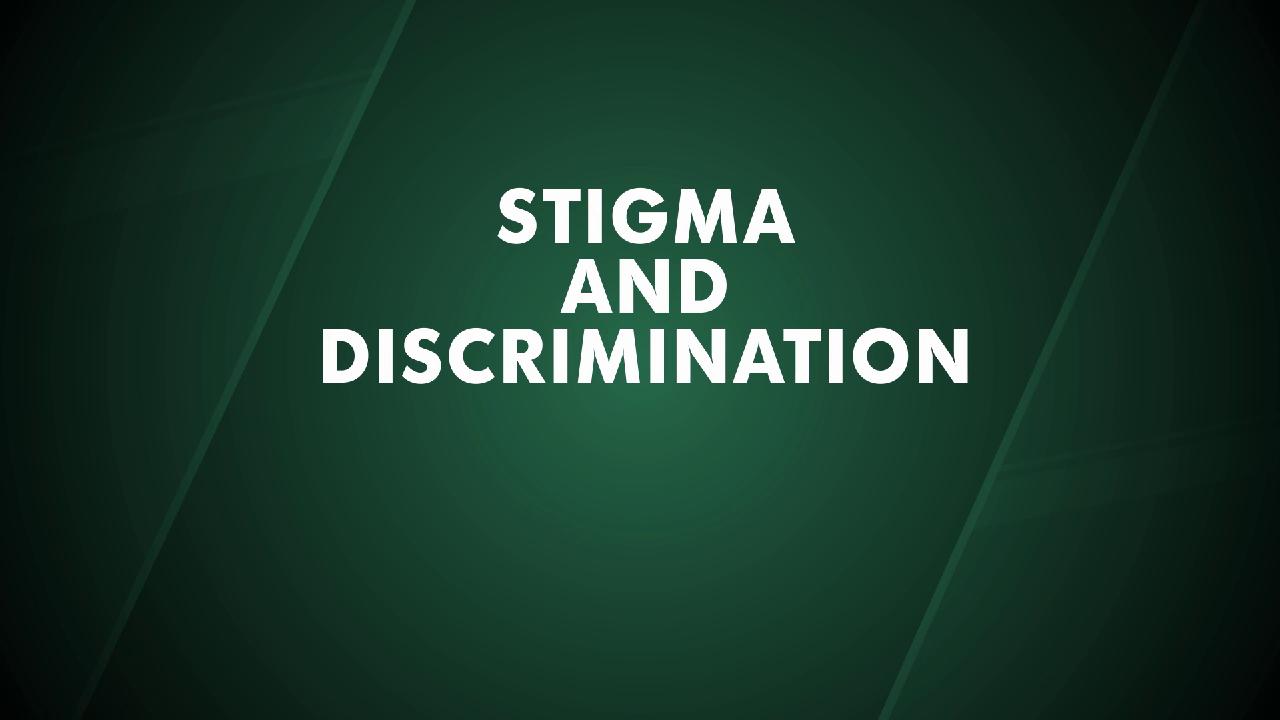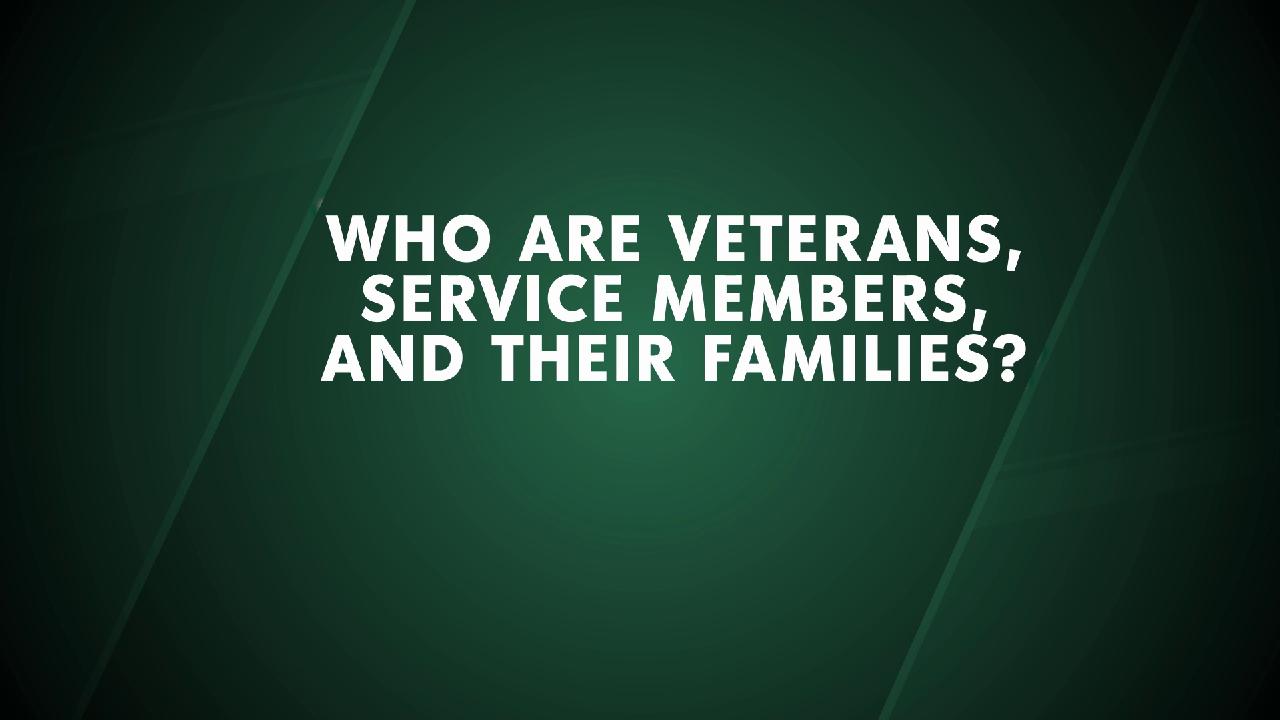Ask the Question
Adding the question “Have you or a family member ever served in the military?” to intake/enrollment/health history forms allows for more informed treatment/care planning and the ability to identify optimal and specific military/veteran-specific referrals/resources.

The NH Legislative Commission on PTSD and TBI conducted a survey of NH Veterans to identify barriers to military-veteran populations accessing needed care. When asked why they were not getting the help they need, Veterans identified that one of the biggest challenges is not feeling understood by the providers who serve them.
There are 94,508 veterans living in New Hampshire, and it’s the 10th largest veteran population per capita in the nation. For a variety of reasons, only 30,000 receive their healthcare at the VA Medical Center. Not all veterans are eligible for care through the Veterans Administration and some veterans choose not to seek care there. The Ask the Question Campaign was designed to educate and engage civilian service providers in better understanding and providing support and care to our military.
Adding the question “Have you or a family member ever served in the military?” to intake/enrollment/health history forms opens the conversation between military experience and presenting problems and needs. Opening the conversation about military experience allows for more informed treatment/care planning and the ability to identify the optimal and specific military/veteran-specific referrals/resources.
Access the Ask the Question website for resources you, or your organization, can use to better serve NH Veterans. Valuable resources such as the Ask the Question Toolkit and the Military & Veteran Family Resource Guide and Educator Supplement are available on the website.
Go to the Ask the Question website

This 10-part video series discusses why you should ask the question: "Have you or a family member ever served in the military?" and is designed to supplement the "Ask the Question" Toolkit.
Ask the Question: Introduction
Ask the Question Introduction
Ask the Question: Introduction
Ask the Question: Introduction
Transcript of video:
Thank you so much for your interest in providing culturally and clinically competent care to veterans, service members, and their families.
The Ask the Question Toolkit is intended to aide senior management and health care administrators, clinical providers and leaders,
case managers and care coordinators, directors, managers, cultural diversity leaders, marketing managers,
public relations managers, grant and charitable funds managers, and even IT support
to work together to improve access to and quality of care for veterans, service members, and their families.
The Ask the Question Toolkit was born in a conference room in the State House of NH where a dozen or so professionals and citizens from all corners of health care, public service, and private sector industries came together every month to serve the NH Legislative Commission on PTSD & TBI
After a survey of NH’s veterans and service members, a few common and deeply impactful themes came to light.
1) that veterans and service members did not feel understood by the health care providers who were serving them,
2) that the VA cannot do it all, and that many of them chose not to get their care through the VA
3) that the impact military service has on the family was often misunderstood or ignored by the health care service industry and other settings.
One of the driving forces behind the development of this Toolkit was the fact that the majority of veterans eligible for VA services choose to get their care in the private sector. This is true across the country. This factor alone exemplifies the need for civilian health care and service providers to be educated and prepared to recognize the unique culture of the military, the possible and common exposures, and the types of medical conditions often associated with military service.
It’s no surprise that civilian health care and service providers are often unfamiliar with the nuances of this population. The vast majority of health care professionals have no military background and minimal exposure to military culture. With less than 1% of the US population having served in the military and the largest portion of those who serve coming from lower middle income to working class families, the culture gap between health care professionals and those who serve is wide.
Many who have never served in the military may not be aware that the training and physical demands of service alone, even without deployments or combat, often contribute to unique physical ailments, injuries, and chemical exposures that can result in health problems over the duration of that individual’s life.
Hearing loss, arthritis, cancers, migraines, joint deterioration, and chronic pain frequently develop along with other associated conditions at a much younger age than is typical for the civilian population. Not to mention the psychological, behavioral, and emotional characteristics of service, deployments, and combat.
You might be saying to yourself, “I don’t think we even have any veterans or military people that come to our clinic” and you may be right… but you’re probably wrong. Have you ever asked? Do any of your intake forms ask the question “Have you or anyone in your family ever served in the military?” Many people who have served don’t self-disclose. Some don’t believe it’s of any importance to their health, others may fear encountering stereotypes or stigma associated with military service, politics, and war. And still others don’t believe that the nature of their service qualifies or is deserving of appreciation or acknowledgement. You won’t know unless you ask, and you won’t get the answers you need unless you ask the right questions.
So- why should your health care or service delivery setting take special care with veterans, service members, and their families? Well, let’s first consider that it is simply the right thing to do. Preparing your facility and providers to deliver culturally competent and informed care is a way to thank those who have served for their commitment and sacrifice.
Second, if your facility or providers accept Veterans Choice, Tricare, or Martins Point- it is your responsibility as a facility to be prepared to provide competent and informed care to the individuals associated with that coverage. Accepting those exclusive coverages is a promise to those who have served that you are prepared to meet their unique needs.
Third, care capacity is needed in the private sector. In many states, VA accessibility whether it be proximity or capacity is a chronic challenge. NH is no exception. Due to this challenge in NH, an exemption was provided at a national level to allow all veterans enrolled in the VA to use Veterans Choice to get care in their communities- with no restrictions based on proximity or availability of services at the nearest VA. Therefore, non-government health care facilities and service providers must be equipped to meet the needs of this population.
But most importantly, preparing your facilities and providers to serve this population saves lives. Those who have served may exhibit symptoms that are difficult to understand without the context of past military experience and exposures. These differences can be relevant at any point in the individual’s life cycle, whether it be 20 days after discharge or 40 years after a combat deployment. Without investigation by the provider into possible injuries and exposures, many symptoms and conditions can go unacknowledged, undiagnosed, and untreated, leading to health care alienation, worsening conditions, and even permanent disability or death.
Thank you again for taking steps toward a more inclusive, competent, and clinically informed health care and service environment for veterans, service members and their families.
Ask the Question: History of "Ask the Question" in New Hampshire
History of "Ask the Question" in New Hampshire.
Ask the Question: History of "Ask the Question" in New Hampshire
Ask the Question: History of "Ask the Question" in New Hampshire
Transcript of video:
The State of NH and the Ask the Question campaign owes a huge debt of gratitude to the passion and tenacity of a woman named Lt Colonel Stephanie Riley.
I met Lt Colonel Riley back in the early days of the NH Legislative Commission on PTDS and TBI. The Commission had been tasked with studying the effects of PTSD and TBI on NH’s returning veterans from the conflicts in Iraq and Afghanistan.
The wars had been on for nearly 10 years and it had become apparent that men and women were coming home with needs that our state might not be prepared to address.
Lt Colonel Riley was serving in the NH Air National Guard.
We connected over being working moms with busy children and professions in health care.
Lt Colonel Riley worked in the emergency room of a NH civilian hospital.
By 2013 she had begun sharing with us on the commission that she was frequently witnessing individuals presenting with symptoms of headaches, dizziness and sometimes hearing loss.
Many were irritable and depressed, struggling with their jobs and relationships.
Based on their presenting symptoms, these patients were often diagnosed with migraines, provided short term medications and sent on their way.
Lt Colonel Riley began to notice, based on her own service experience, that many of these individuals might have served in the military, things like t-shirts, tattoos or combat boots, so she began to ask them.
She discovered that many of the migraine patients were actually veterans, possibly suffering from mild traumatic brain injuries or TBIs.
Later that same year, Lt Colonel Riley encountered a veteran struggling with chronic head pain and other life difficulties.
He had been to three different health care facilities in NH and not one had asked him if he had ever served in the military.
By the time this veteran encountered Lt Colonel Riley, it was too late. Despite her efforts to help him get an accurate diagnosis and relevant treatment, the veteran died by suicide.
Devastated, Lt Colonel Riley expressed her concern to many NH military and civilian leaders. I remember the day she arrived at our monthly commission meeting, still deeply emotional over the loss of this young veteran and her frustration with the system’s failure to catch him.
The seed for the Ask the Question campaign was planted in NH that day.
Lt Colonel Riley recognized the critical role that community service providers play in providing services and care to veterans, service members and their families.
The fact is, across the country, over two-thirds of veterans choose to receive care and services in their community rather than at their local VA.
Tragically, Lt Colonel Riley was later diagnosed with cancer. She passed away in December of 2014. She continued to attend commission meetings throughout her treatments and expressed frustration that her providers seemed to lack interest in the fact that she had served,
or that exposures during her deployments may have played a role in her illness.
In April of 2014, the spring before she passed, Lt Colonel Riley took her story to the Commission’s facebook page:
Today I went to Dana Farber in Boston for my second opinion in my cancer diagnosis. Throughout this latest medical journey I have been on, no one in the medical community has asked me if I have ever served in the military, because to them I look like a civilian.
I have served on this Commission for a couple of years, and we have tried promoting medical services, or any community service for that matter, to start asking the question "Have you ever served in the military?" when doing an intake form. Don't ask if the person is a veteran. Many folks don't identify with being a veteran despite serving in the military, so the question might not be answered correctly. If the response to military service is a yes, the person may be entitled to VA benefits and not know it, and NOT be an uninsured person.
The person may be having symptoms related to a recent deployment; such as migraines from an undiagnosed TBI from an IED explosion, so a correct diagnosis can be made during the medical visit. The person may not associate symptoms to a military injury and by asking the question may remind them.
Just one simple question can open up so many opportunities to help the person.
I am passionate about this cause because a few years ago, I worked as the case manager for the NH Army National Guard. I worked with soldiers returning from deployments and tried to get them plugged Into the VA for their care. Many service members do not go to the VA. Instead they will go to their local community hospitals for care. One of my "kids” was going to different hospitals seeking help for his terrible migraines. He had been in IED explosions, had lost his roommate to one of the bombs, and was having a bad time adjusting back home. Because no one knew of his background he was not diagnosed properly. He was given pain meds for his migraines and sent home. When I became aware of this we got him into the VA but by this time he had been suffering too much and he chose to end his life. I have never been more devastated in my life and have tried to do something to change the system. Because it is SO hard to have questions added to intake or triage forms (why that is is BEYOND ME!) I have decided to do what I can.
I wore my military uniform to Boston to give them a visual that I am in the military. At the end of my appointment with my doctor, I explained to him about the uniform and the question. He felt rather sheepish that he didn't ask. I told him that I had been deployed to Qatar in the past and maybe all the sand had done something to my lungs. I asked him to look into changing the forms at his facility. I’II follow up on that at my next visit. He's a great guy. Maybe he will do something.
Lt Colonel Riley mentioned in her post the importance of asking the question the right way.
Some medical facilities and forms have included the question “Are you a Veteran?” for decades, mostly because it might play a role in billing.
But that question is much too narrow and has not historically been followed up with important health related questions.
How we ask the question is critical to engaging those who have served and their family members. Not everyone who might qualify as a Veteran identifies as a veteran.
Some who served do not feel that the nature of their service is deserving of the title.
They may have personal beliefs that such a title should be reserved only for those who were deployed, or experienced combat, or were wounded.
Some, despite their time in service, do not actually qualify for the title because maybe their discharge status prohibits it, or maybe their service was in the national guard or reserves, and they were never activated.
What about those still actively serving? They wouldn’t identify as veterans until they were out of the military.
The word “ever” is important because we want anyone who has ever served their country to feel included,
even if the person was dishonorably discharged or was released before completing basic training.
The word also makes clear that service of any era, peace time or war, is of value and important to disclose.
The word ever allows us to identify anyone who might be in some way impacted by the unique culture and possible exposures of military service.
Across the country we are quickly learning that to best serve our veterans, service members and their families, we need to first identify them.
We need to identify them within our hospitals, mental health centers, senior centers, social service agencies, employment offices, law enforcement agencies, courts, and schools.
NH’s Community Mental Health Center military liaison initiative is a powerful example of how one health care system in NH operationalized the “Ask the Question” campaign.
Through Ask the Question, we now know that 18% of clients served at the 10 NH mental health centers are military connected.
This new data helped to create intentional strategies to serve military connected patients and clients by generating military culture trainings, coordinating client referrals to the VA when relevant, and providing greater supports for military families.
NH’s Ask the Question campaign was highlighted at the national mental health summit organized by the department of defense, US department of veterans administration, and the US department of health and human services.
As a result of this discussion, the Ask the Question campaign was approved to be included in the national suicide prevention planning documents.
Many of those who have served do not ask for help easily; military culture dictates self-sufficiency and sacrifice.
Many are resistant to accepting resources or supports because they believe that there is probably a veteran out there that needs it more than they do.
I could not possibly count the number of times a veteran has apologized in my office for taking up my time because he is certain that someone else’s problems are much worse than his.
The Ask the Question campaign puts the responsibility on the service provider, on all of us, to identify possible needs, thus removing these barriers for veterans, service members, and their families.
Thank you, Lt Col Riley for your service to our state and your service to our country. Your message proves to us again and again that one person can make a difference.
Ask the Question: Military Health History & Other Important Questions
Ask the Question: military health history and other important questions
Ask the Question: Military Health History & Other Important Questions
Ask the Question: Military Health History & Other Important Questions
Transcript of video:
One of the ways that health care facilities can be sure to capture important health information from service members and veterans is to take a Military Service Health History.
To start, a brief military service health history can be taken at intake and included with the packet of forms that all of your clients or patients complete when they come into your facility or practice for care.
The form included in the Toolkit is an example and can be adapted for the needs of your specific service or industry.
The form asks 6 basic questions but does not request any specific details.
Those details can come later, during the conversation with the provider.
An important detail on the military service history that should not be removed when adapting the form to your facilities’ needs is the explanation at the top regarding why we are asking for this information.
The explanation reads:
Why are we asking for this information? Military service comes with some unique experiences and exposures, many that civilians would never have. Some of those experiences or exposures might affect your health, now or in the future. Knowing this can help us make sure we are aware of all possible factors when it comes to any health concerns you may have or diagnosis or treatments you may need.
Keep in mind that some veterans and service members worry that by talking about their service they will be subjected to stereotypes and misunderstanding.
It is important that the form makes clear why the information is important.
It is also important to respect an individual’s decision to decline providing the information.
The Toolkit includes an information sheet that can be given to patients, as well as a script to help providers and staff members answer frequently asked questions about the importance of military health information.
The Military Service Health History goes on to ask for the branch and dates of service.
This information is important because certain branches and certain times of service are more likely to encounter certain types of exposures.
For example, someone who served in the Navy during WWII is much more likely to have been exposed to high amounts of asbestos than someone who served in the Army during the same period.
Detailed information on such exposures can be found in the Toolkit under Common Military Environmental Exposures.
The questions go on to ask:
1) Do you have a service-connected condition or are you rated at the VA for any injures or experiences?
This information is important for many reasons, but not the least of which is that you as the individual’s provider should be made aware of any conditions your patient may be treated for in other places, or signs and symptoms you should be sensitive to in your exams. A service connected condition or rating could be as complicated as a blood borne illness or as simple as a scar. Some come with disability benefits paid monthly and access to certain services through the VA, while others are simply for documentation purposes in the event some issues arise later.
2) Do you receive any of your health care at the VA?
3) ….
Asking these questions not only provides vital information for the individual’s health care,
but it also prompts the veteran or service member to think about their military experiences as relevant to their health
and thus improves the chances that important information will be disclosed.
The veteran or service member may downplay or minimize his or her answers to some of these questions,
like “oh sure I was exposed to lots of blasts, but I’m fine!”
And they might very well be but documenting that exposure in their medical history will be
important later if symptoms or conditions develop over the course of their life.
So what do you do when the answer to any of these questions is YES?
The Toolkit provides a step by step worksheet to help guide you and your providers through this process
in a quick and efficient way
that will allow for important information gathering and rapport building.
The first 2 steps in the worksheet can be applied by any staff member at any time.
Step 3, 4 and 5 are only necessary when the answers to the previous questions dictate it and are not to be taken lightly.
These are intended for care and service delivery only and should only be asked in a private, professional setting.
To start, you will ask the veteran or service member if they mind if you ask them a few health-related questions about their military service...
Some of the questions will already be answered on the Military Service Heath History form. No need to ask them again, simply follow up on the answers with the associated questions on the worksheet.
For example, if the individual answered YES to Did you have any illness or Injuries while in the service, simply follow up with the appropriate investigation for details.
Ask all of the questions in bold.
When the answer is YES, in the Toolkit there are associated screening tools that can help with diagnosis and treatment planning,
as well as resources to offer the veteran or service member.
All yes responses and the relevant details should be recorded in the patient’s problem list in their medical record
so that all medical encounters and associated providers will have the opportunity to consider the impact of the noted exposures or needs on any presenting concern.
This information, documented by your facility, might also be an integral part of a veteran or service member’s VA compensation claim,
whether it be the first documentation of the injury or illness or record of a worsening condition.
The Toolkit also includes a detailed step by step worksheet that staff and providers can use when talking with a family member of a service member or veteran.
That worksheet helps to identify and address any care giver issues if relevant-
or any financial, physical, or emotional difficulties related to their loved-one’s military service
that they themselves might be experiencing.
Don’t forget, the family serves too.
Ask the Question: Stigma & Discrimination
Stigma & Discrimination
Ask the Question: Stigma & Discrimination
Ask the Question: Stigma & Discrimination
Transcript of video:
In his 2nd Inaugural address in 1865, President Abraham Lincoln called upon congress
“to care for him who shall have borne the battle and for his widow and his orphan”
This quote was later adopted as the motto for the Veterans Administration
When the civil war broke out in 1861, the nation had about 80,000 war veterans.
By the end of the war in 1865, another 1.9 million veterans had been added to the rolls.
At the time, this included only veterans of union forces.
The General Pension Act of 1862 provided disability payments based on rank and degree of disability, and initiated benefits for widows, children, and dependent relatives.
The law covered military service in times of peace and war.
The inclination and moral imperative to care for those who have “borne the battle”, or served, as well as their families, has existed longer than our nation.
But the federal system has always struggled to meet the ever changing and increasing demand.
Communities have long filled the gaps, cared for their own, and embraced the moral imperative to serve those who have served and undoubtedly will continue to do so.
But capacity and access aren’t the only barriers to veterans, service members and their families getting the care that they need.
Stigma and discrimination play an overwhelming role in the disconnect between community-based care and the individuals that need it.
What does stigma have to do with military veterans, service members, and their families?
Well- in research nationwide, stigma has been identified as the #1 barrier to accessing health care for this population.
More specifically, many veterans report feeling embarrassed or ashamed of their needs (we call this internalized stigma)
as well as believing that providers will judge them negatively for having served or will simply not understand them or their needs (we call this external stigma).
The perception that health care providers do not understand veterans stems from the fact that the vast majority of health care professionals have no military background
and minimal exposure to military culture.
With less than 1% of the US population having served in the military
and the largest portion of those who serve coming from lower middle income to working class families,
the culture gap between health care professionals and those who serve is wide.
As a result, many veterans and service members fear that the lack of understanding will result in stereotypes,
pathologized interactions, misunderstandings, over-glorification, or negative judgements,
about their identity and their experiences.
Even the most well-meaning can find themselves entangled in stereotypical perceptions of military service.
Stigma and discrimination are informed by the assumptions and perceptions we hold about
the WHO and the WHY motivating military service.
Who do we think chooses to serve in the military?
Why do we think they choose to serve?
What type of person do we think chooses the military?
How do we think it affects them?
You may think differently about a service member or veteran who enlisted immediately after the terrorist attacks on 9/11, than you do about a service member or veteran who enlisted during peacetime.
What about those who were drafted? Do you celebrate their service? Do you feel bad for them?
What do you make of those who go to a military academy or college first, versus those who sign on the line before they even graduate from high school?
Understanding your perceptions and assumptions is the first step to combating stigma and decreasing the potential for discrimination.
For many veterans, stigma exists within, in the form of shame and guilt over their needs and sometimes their deeds.
But stigma is also imposed externally in the form of assumptions and misperceptions about who a person is based on the uniform.
Education and exposure is the best defense.
So, what can you do? Well- rapport begins at the front door.
Here are some simple starting points to create a more validating environment for veterans, service members and their families:
Make sure your lobby has an American flag or the facility has one flying outside- or both!
Even a simple handheld flag in a vase or jar on the front desk is a good start and sends a subtle but positive message.
Encourage any staff members that have served, or who have a close family member that serves
to wear some sort of identifier on their uniform or clothing.
A yellow ribbon, a branch specific pin or flag pin, a lanyard that says Airforce Mom or US Army Retired.
Remember, for many veterans, they might identify with their service branch the way others might identify with their university or college.
Making that connection builds immediate rapport and rapport leads to improved communication and understanding in all settings, but especially in health care.
A simple rule for main entry greeters, receptionists, and front desk staff is to acknowledge warmly and with gratitude, everyone entering in uniform,
as well as those individuals who display service or military affiliation on a hat, shirt, or in some other clear and positive way.
They might say:
Good morning, I noticed your hat- thank you for your service!
Or
Vietnam Veteran? Wow, let me just say, welcome home.
Consider engaging children accompanied by a parent who is wearing a symbol of service by making an exclamation such as “Wow! Your mom is a Marine? You must be very proud!”
Please do not forget that women serve too, and they always have.
Be sure to acknowledge the elderly woman wheeling her veteran husband into the lobby- ask her if she served too.
If you served or have a personal connection to military service, don’t be afraid to say so.
Just keep it light and positive and avoid telling stories about someone else’s experiences.
Be sure you are willing to accept gratitude in return if the individual chooses to thank YOU for your service or your family connection.
And finally, never insert or engage in political discussions or references when greeting or showing appreciation to someone who has served.
If the individual brings it up, politely dodge or exit the conversation.
Politics have no place in expressions of appreciation for service and are a mine field for assumptions and stereotypes on both sides.
There are many more ways to build rapport,
from a warm greeting at the front door to Asking the Question in the exam room.
Rapport combats stigma and discrimination.
The toolkit can help you find what strategies will work best for your facility, staff, and service industry.
Ask the Question: Who are VSMF?
Who Are Veterans, Service Members, and their Families?
Ask the Question: Who are VSMF?
Ask the Question: Who are VSMF?
Transcript of video:
“Have you or a family member ever served in the military?”
That is the question that informs this Toolkit, but what are we really asking?
It’s important to appreciate that each word in this question has value and purpose.
Of the utmost importance is “ever served in the military”. The question must be asked in a manner that allows all who have ever worn the uniform to feel included in the inquiry.
We cannot ask “Are you a Veteran?” if we hope to truly capture the richness of an individual’s experiences and connection to military service.
Not everyone who might federally qualify as a Veteran identifies as a veteran.
Some who served do not feel that the nature of their service is deserving of the title.
They may have personal beliefs that such a title should be reserved only for those who were deployed, or experienced combat, or were wounded.
Some, despite their time in service, do not qualify for the title because: their discharge status prohibits it,
or maybe their service was in the national guard or reserves, and they were never activated.
What about those still actively serving? They wouldn’t identify as a veteran until they were out of the military.
The word “ever” is important because we want anyone who has ever served their country to feel included,
even if the person was dishonorably discharged, or was released before completing basic training.
The word also makes clear that service of any era, peace time or war, is of value and important to disclose.
So who is a Veteran?
According to Title 38 of the Code of Federal Regulations, a “Veteran” is defined as “a person who served in the active military, naval, or air service and who was discharged or released under conditions other than dishonorable”.
A dishonorable discharge strips an individual of all titles and benefits of their service, including the term veteran.
This definition only has relevance when talking about federal veterans’ benefits, VA care, and qualifications for veteran services outside of your facility
For the purposes of this Toolkit, it is imperative that we cast a wide net.
With regard to medical care and service delivery within your facility or organization, a Veteran must be anyone who has ever served, for any length of time, in any military service branch.
Regardless of their time in or discharge status, these individuals may have encountered exposures and experiences that make them medically and culturally unique.
Appreciating that information can make the difference between life and death for someone who has ever served.
The bottom line is this;
when serving those who have ever served within in your own facility,
follow the any, any, any definition of a Veteran (any person, for any length of time, in any military service branch).
When considering a referral to outside care or services, a more careful investigation into the nature of their service may be required.
So now that we have considered who is a Veteran, lets talk about who is a “service member”.
The term service member means a current member of the uniformed services consisting of the armed forces (army, navy, air force, marine corps, and coast guard).
Much like the definition of a veteran, with regard to medical care and service delivery within your facility or organization, a service member is anyone currently serving in any capacity, who puts on the uniform as required for duty or training.
These individuals, despite status as active duty, guard, or reserve may have encountered exposures and experiences that make them medically and culturally unique.
Whether they put the uniform on for one weekend a month or every single day, for the purposes of health care and services, they are a service member.
If you are curious about the differences between active duty, or guard, or reserves, or you’d like to learn more about what the different discharge statuses mean, I encourage you to review the section in the Toolkit titled Understanding the Difference Between Types of Military Service.
And finally, who is a “family member”?
The term family member, as it applies to the Ask the Question initiative, can be anyone closely associated with a veteran or service member,
such that they have been touched or affected by the culture of military service, or the after-effects of their loved-one’s military experiences.
This can include children, parents, spouses, close friends, intimate partners, siblings, grandparents.
There is no limit to this definition and your facility and organization should strive to be inclusive of all possible connections and the richness and value those connections can bring to your service and care delivery.
Again, when considering VA funded or VA services,
who qualifies as a family member or dependent has specific criteria.
But for the purposes of this Toolkit, there are no limits.
Ask the Question: When the Answer is "Yes"
When the answer is yes, link and collaborate
Ask the Question: When the Answer is "Yes"
Ask the Question: When the Answer is "Yes"
Transcript of video:
So you’ve asked the question
And taken a Military Service Health History
Now what?
Sometimes, after a good military health history is taken,
or at any point in treatment or care,
you might find that what the veteran needs exceeds what your facility or providers are able to treat,
or you might know that another service,
specific to military and service members,
might be better suited for their needs
or may even be less expensive or free.
The unique needs, exposures and experiences of those who have served in the military sometimes require a willingness to collaborate and link with other means for appropriate care and services.
The Toolkit includes many different resources and tools to help determine when referrals are necessary and how to talk to the patient about his or her options.
One topic to be sensitive to is a referral to the VA.
Most veterans, even if they are eligible, chose not to get their care at the VA.
There may be several reasons for this-
but the most common is the perception that the VA should be reserved for veterans who really need it.
Meaning those who might not have health insurance to access private medical care.
Some believe that the VA’s care is substandard or only meant for catastrophic injuries or illness.
The reality is that the VA’s care is comprehensive and, for many specialties, state of the art.
But another reality is that capacity is a chronic issue
and wait times for appointments and needed care are infamously long.
Another important factor when considering referral to the VA is that while the Toolkit treats anyone who ever served for any length of time as a veteran,
the VA health care system does not,
and eligibility must be met if the patient is not already enrolled.
The Toolkit provides detailed information that can help providers and patients determine if they might be eligible for VA services.
When suggesting a referral to the VA for care, you may face some resistance.
It will be important to be respectful of the patient’s feelings but also take time to clarify the benefits of the referral and educate on some of the processes.
You might find that the veteran feels rejected or dismissed.
Some of the stigma fears associated with military service and seeking health care are that private providers and facilities don’t want to deal with them or their needs.
This also includes concerns that their military health insurance such as TriCare doesn’t reimburse as well as privately funded insurance
and therefore facilities do not want to treat them.
It is important to reassure and explain how the referral is in their best interest,
how it may be specific to a certain health concern or problem they might have that is better suited for the VA,
and that you and your facility are more than willing to continue to serve them for other health care needs.
The Toolkit includes a worksheet with tips and information on how to talk to patients about referral to the VA.
Identifying a military liaison in your facility who makes it a priority to be educated on these issues and who can guide patients through the process can save valuable provider time
and is an indicator to veterans, service members, and their families that your facility or organization takes their care seriously
and appreciates their service.
Here are some examples of when to consider a referral to the VA:
Some veterans are not required to make copays at the VA- some veterans even qualify for free healthcare.
If you have a patient who is struggling financially to engage in the care that they need,
or has a high deductible and an expensive procedure is needed,
explore the VA as an option for their needs.
Many VA-enrolled veterans can get very low cost or free prescriptions, even for illness and ailments being treated in your facility.
Some important services are free to all VA-enrolled veterans:
such as…
smoking cessation or weight loss programs,
special screenings and exams related to common exposures and health risks associated with service,
Counseling for military sexual trauma,
readjustment counseling,
certain cancer care treatments,
and hospice care, to name a few.
Do not assume that veterans know what they are eligible for. They often don’t.
Here’s a quick tip that might help encourage a reluctant veteran to enroll in VA care.
Many veterans do not know that by enrolling in their local VA,
even if they never use it for any of their health care,
they will actually help all veterans in their region.
Individual VAs are federally funded and sourced based on the number of veterans enrolled.
The more veterans enrolled, the more federal money for services that particular VA receives.
Encouraging all veterans who are eligible to enroll in their local VA,
even helping them do it,
will improve quality and access to care for all of the veterans who rely on that VA for their health care.
There is no downside to enrolling in VA care.
They may never choose to use it, but they will help all of the other veterans who do.
This Toolkit provides handouts that your providers and facilities can give to patients.
The handouts contain information on how to determine eligibility,
how to enroll in their local VA,
how to file a VA disability claim
and even how to contest or request an upgrade in discharge status.
Use the handouts as is or adapt them to fit your facilities needs.
In addition to the VA, individual states and communities often have services,
charitable organizations and funds meant to support those who have served and their families.
These services can be financial, health related, employment related, housing supports and the like.
This Toolkit includes many different resources for those living in NH.
And these kinds of services, when not federally funded or supported, often have a broader definition of a veteran
and thus allow for supports and services to be extended to those who otherwise may not be eligible for VA benefits and supports.
Linking veterans to other services,
staying aware of the collaborative services that are available- including programs at the VA,
can be a time-consuming task.
It cannot be emphasized enough how valuable a military liaison in your facility can be.
Ask the Question: Building a Team
Building a Team and Fostering a Culture
Ask the Question: Building a Team
Ask the Question: Building a Team
Transcript of video:
When starting a new initiative, it’s important to involve valuable people and the right people. Every new initiative needs a cheerleader or someone to blaze the way forward and recruit others to participate. Initiatives are rarely successful or sustainable when they are designed and implemented by one person, so you don’t want to do this alone!
Identifying Service members, Veterans and their family members in your organization, practice, or business will result in better service and treatment outcomes for those individuals. To successfully implement a new policy or practice to identify this population, the Ask the Question Toolkit developed in New Hampshire recommends the following steps to build a team and foster a culture. It is publicly available on the NH State Department of Military Affairs and Veterans Services website for any interested party inside or outside New Hampshire.
Step #1 is to identify and bolster stakeholders.
While senior-level management ultimately has the responsibility for the culture of an organization, there are other interested and viable stakeholders throughout every level of the organization who should be actively engaged and can help ensure success.
Obtain commitment from executive leadership in the beginning as their support will be valuable as the initiate is implemented.
Engage Veteran employees and/or clients/patients/customers in the process as well when it’s possible and appropriate.
Engage non-Veteran employees from organizational areas you identify as important to the initiative. This might be clinical, administrative or IT positions depending on your vision and what needs to be implemented.
Look for people who will have a passion for the initiative. Not all employees have served in the military, but many will have family members or friends who have done so and they may value the mission of Asking the Question.
A multi-disciplinary team will bring diversity and passion to your own internal Ask the Question campaign.
The Ask the Question Toolkit provides detailed recommendations on how to reach out to others in your organization and how to describe the purpose of Ask the Question.
The second step recommended in building a team and fostering a culture is to educate leadership, employees and staff through internal strategies and external training opportunities about the importance of, and reason for, identifying Service members, Veterans and their family members. The employees of your organization need to understand the purpose, intent and desired outcomes of a new policy or practice in order to put forth the effort required for it become a new routine.
There are a variety of strategies recommended in the Ask the Question Toolkit to help your organization change its culture around identifying Service members, Veterans and their families. One suggestion is for Human Resources staff to develop a way to identify who has previously served when onboarding new employees. If you are going to begin identifying SMVF clients, then you can begin to show employees how much you value this by also identifying the Service members and Veterans you have employed. Consider encouraging those who choose to self-identify as having served to display their military affiliation on a name badge, lapel, lanyard or door nameplate. This type of strategy demonstrates a commitment and will begin to foster a culture of appreciation for military service. Refer to the Ask the Question Toolkit for additional strategies.
Formalize your organization’s commitment to this culture change by providing all employees with the opportunity to gain knowledge about military culture through training opportunities. There are a variety of training resources available including in-person trainings, online training, training that offers CEUs and those that do not, training with a cost and free trainings. In NH, you can get more information about military culture trainings available by contacting the NH Division for Community Based Military Programs at the Dept of Military Affairs and Veterans Services, but if you are in a different state, I’d encourage you to call the Department of Military Affairs in your own state to ask about available training resources. One high-quality training resource available nationally that I recommend is PsychArmor. PsychArmor specializes in military culture educational products for healthcare providers, Veterans, employers, military family members and more. PsychArmor creates and build custom learning pathways tailored to meet your organization’s needs and also has more than 250 free courses currently available to individual learners online. In New Hampshire, we have a customized Military Culture Online Training Portal free to providers that was created by PsychArmor. You can find more information about this at our Dept of Military Affairs & Veterans Website or access it with the QR code you see here.
A third step to building a team and fostering a culture is to educate those you are serving about the initiative or new policy or practice. Culture change requires consistency and consistent messaging to all stakeholders including the individuals you serve as patients, clients or customers. For the initiative to be successful, the what and why of your message and efforts must be confidently and consistently delivered.
Create a 30-second overview of the initiative or an “elevator pitch” that can be shared with internal colleagues and external customers or stakeholders. The listener to your “elevator pitch” needs to walk away understanding the importance of the initiative as it pertains to their role in or related to your organization. Tools are available in NH’s Ask the Question Toolkit to help you ensure consistent messaging.
These steps should help get you started with building a team and fostering a culture so that the initiative can be sustainable and successful. The Ask the Question Toolkit has a bunch of information, tools and resources that can provide more support for your initiative. Please check it out by visiting our website or using the QR code shown!
Ask the Question: Ask with Strategic Intent
Ask the Question: Ask with Strategic Intent
Ask the Question: Ask with Strategic Intent
Ask the Question: Ask with Strategic Intent
Transcript of video:
Before an organization begins a practice of identifying Service members, Veterans and/or their family members it is necessary for the organization’s internal team to identify for themselves what the strategic intent is behind asking and identifying. Consider why you need to ask— what do you want for an outcome? Knowing why you’re asking before you ask will allow the team to carefully craft the form in which the client/customer/patient is being asked and then, consequently, what form their answers can take. Strategic intent up front will help you avoid collecting information that is not useful to you, your organization or the person you are serving. A great example of what can happen if you are not carefully strategic about this in the beginning is a survey that has been distributed to youth in New Hampshire. The survey is designed to identify youth at risk for certain behaviors and is given annually. The survey asks “Has anyone in your family ever served in the military?”. There is no further explanation or defining guidelines for answering this question. One year, evaluators of the survey responses picked up on the fact that many more youth self-identified themselves as being part of a military family than would have been expected given estimates of how many military families were living in the state at the time of the survey. Further investigation uncovered that a large number of youth who answered “yes” to that question were proudly referring to uncles, aunts, grandparents, great-grandparents or even ancestors who had served generations ago. The intention of the question had been to identify youth of military families—youth who had a parent or immediate household family member currently serving in the military or who had previously served in the military. But because the question was not specific enough, the results were then not useful at all to those who needed the information. Researchers and local providers wanted to know what problems or challenges existed for the youth military/Veteran families in the community today. The service history of a child’s ancestor who served in World War 2 cannot be clearly linked to risks the child may experience today and is not substantially relevant. Some organizations will want to know if a customer is currently and actively serving or if they have previously served. It will be important for some to know where and when the customer served because it that information could influence treatment decisions or what might be available for resources. Some will be interested in tracking the needs and outcomes related to spouses or family members of those served. If your organization needs to know more information about service or the customer’s relation to the person who served, then follow up questions will be required and should be carefully considered. Another example to learn from with regards to how data can be skewed if not collected properly comes from a group of mental health professionals who were collecting and analyzing data related to Service members, Veterans and their family members and risk factors for mental health challenges. All practices participating in the project agreed to identify SMVF at the time of intake. They all asked “Have you or anyone in your immediate family ever served in the military?”. They clearly identified “immediate family” which was good. But, when someone answered “yes”, they did not then drill down to find out if the person answering was the one who served or was the family member. Data collected showed that this group of clients were at higher risk in a variety of categories, but it was not clear who the individuals were exactly so it ended up not being as useful as it could have been in that form. The final step I want to recommend to you today that will help you to be strategic in your efforts to identify SMVF is to formalize and operationalize the way you will identify the population in order to sustain this as a new policy or practice. Developing formalized policies and/or practices are the ways to ensure that the initiative and efforts do not subside or get lost over time. Over the course of an organization’s lifetime, there will be turn over in staff and there will not always be someone as passionate as you about identifying the SMVF being served by your organization. Engage leadership and appropriate staff in the organization to formalize a process that can be documented in policies and practices. This will help new staff learn the procedure, its importance and how to seamlessly incorporate it into their routines. It will also ensure consistency throughout the process and a clear understanding among staff about roles and responsibilities related to what happens when the answer to “Have you or anyone in your family ever served in the military?” is “yes”. Organizations are encouraged to take the time necessary to explore what happens when someone answers “yes” to that question. Start from the very beginning—who is the first person to see that answer or who should be the first person to look for that answer and what will they be expected to do with it? Identify each staff person or program where that information will be passed or shared and identify what happens with that information when it is received and where it goes next. Be very clear and document the process in writing to share with all employees and customers. The Ask the Question Toolkit developed in New Hampshire is publicly available on the NH State Department of Military Affairs and Veterans Services website for any interested party inside or outside New Hampshire. It goes into detail about how to effectively Ask the Question and provides tools and resources for helping organizations do that. As you work to develop a policy or practice around identifying SMVF, carefully consider why you’re asking, what information you want to get as a result of asking and how that information should be used in a formalized way to benefit the person you are serving. You can access the Ask the Question Toolkit by using the QR code shown.
Ask the Question: The Searles Family Story
Ask the Question: The Searles Family Story
Ask the Question: The Searles Family Story
Ask the Question: The Searles Family Story
Transcript of video:
00:00:06:09 - 00:00:37:18
My husband and I have been married since August of 2010, and five days later, after we got married, he deployed to Iraq. He was gone for over a year. When Dave came home, I thought that his deployment was going to be the hard part, but in reality it was actually the reintegration process that was really hard for us. Dave had gone through a lot of things over in Iraq and really struggled when coming back into civilian life and being part of our family.
00:00:38:18 - 00:01:10:21
As time went on, we ended up having a beautiful little boy named Daniel in 2013. And Daniel was born with a lot of medical complexities. I was a first-time mom really struggling to keep my son alive and also keep my family together, and that was really hard. The hardest part was that nobody really knew what we were going through. From the outside looking in, we looked like a perfect family and had our life together, but in reality we weren't doing well.
00:01:11:22 - 00:01:41:22
And Dave's PTSD, which was undiagnosed at the time, was really affecting him and affecting our family as a whole. We were at the doctors all the time because of our son's medical conditions, yet no one ever knew that there was something wrong because nobody asked. No one knew that we were a military family. They might have checked it off on a box, but our doctors who saw us and who cared for us didn't know. And so they didn't know to ask if we were okay.
00:01:43:07 - 00:01:59:10
The turning point for our family was when Dave's PTSD started to include flashbacks. My fear at that moment was for our young son, who would never understand. So in that moment, we
00:02:01:05 - 00:02:33:03
took some time and separated so that we could come up with a plan to keep everyone safe and to also keep our family together. Part of that plan included treatment at the VA for PTSD, which was a lifesaver. And without it, I don't think that our family would be together. He chose us, which I am very thankful for. He did what he needed to do to get the help. As a military family, we need people to understand what we go through.
00:02:33:05 - 00:03:09:01
We need people who can recognize that we have unique struggles because we're a military family. And you don't know that your patients are in the military or have a military connection unless you ask the question. A simple question of, “Have you or someone in your family ever served in the military?” back when we were struggling as a family may have changed the course of what we were going through. I probably would have just broken down at that point and said, Yeah, like my husband was in the military and served in Iraq and we are not doing well and I don't know what to do.
00:03:09:14 - 00:03:46:16
A lot of people have asked me, “Well, why? Why didn’t you ever say anything? Why didn't you tell us?” And the answer is actually pretty simple. It's that just as my husband was very proud, I was a very proud Army wife, and my job was to keep my family together. And so having to reach out and connect with somebody to say, like, we're not doing well was was really hard for me. And so it's really important that providers here in New Hampshire and across the country take the initiative and open that door for conversation so that families don't feel that burden. Because it's a lot easier when someone else opens the door.
00:03:47:11 - 00:04:21:17
Today, Dave is doing incredible. He had been working at the VA. He is now a registered nurse and loves working and serving other veterans. For us, that's a huge piece of it. It was helping Dave to find his place again within the civilian community because his purpose and his his life was serving our country and having the ability to reconnect into something that gives him purpose and meaning like that was a huge turning point for us.
00:04:22:04 - 00:04:56:19
The Ask the Question campaign is not just about asking a question and checking a box. It's about opening a door to conversation and opening doors to military families so that they feel like you want to hear their story and that you want to support them. Because honestly, our families made a lot of sacrifices so that Dave could be in the service and, it's just really important to us that all of our service members and veterans have a chance to reconnect at home in the way that they did when they were overseas.
Ask the Question: Opportunities to Collaborate
Ask the Question: Opportunities to Collaborate
Ask the Question: Opportunities to Collaborate
Ask the Question: Opportunities to Collaborate
Transcript of video:
If you are a professional who serves Service members, Veterans or their family members in your organization, practice or business you may benefit from connecting to others who do the same in your local area or state. There are a variety of benefits to participating in a Community of Practice or other professional coalition made up of organizations that serve individuals from the same population. Learning about evidence-based, best practices can enhance the services you are providing. Gaining awareness of the services and resources available to the population will ensure that you can provide appropriate referrals when your clients demonstrate needs you cannot meet. And, finding other professionals who can help you address the challenges you may experience when trying to meet the needs of the military/Veteran population can be professionally beneficial. You can learn how to become a voice for the military/Veteran population by being active in groups like this, then use that voice at other tables to make sure the needs of military & Veterans are considered in all types of efforts and initiatives across your state and professional field. I encourage you to get information about these opportunities in your area by contacting your state’s Dept of Military Affairs and Veterans Services. In New Hampshire, you can find information about some of the efforts and groups on the Dept of Military Affairs and Veterans Services website under the Div for Community Based Military Programs. In New Hampshire, we have numerous professional groups, committees and coalitions that would love your participation! Those we serve benefit from the collaborative efforts of professionals across sectors sharing a variety of experiences and professional knowledge. One example is the NH Suicide Prevention Council Military & Veterans Committee which also includes our Governor’s Challenge to Prevent Suicide Among Service Members, Veterans their Families team. Other examples are the Justice Involved Veterans Task Force, the Lakes Region Veterans Coalition, the Community Veterans Engagement Board and the NH Community Partners group hosted by the VA Medical Center. Most states now at least have a Governor’s Challenge to Prevent Suicide among Service members, Veterans and their Families team that is using a multi-disciplinary approach to implement suicide prevention efforts for this population. Find out what is in your community so you can contribute to the work being done, learn from others and collaborate!
Resources
Organizations and providers implementing strategies to Ask the Question: Ask, Link, Collaborate will find valuable and informative resources on this page.
Ask, Link, Collaborate--Starting & Sustaining
A checklist for internal, organizational teams to use in order to evaluate and identify opportunities for ATQ to be operationalized in the organization's policies, practices and procedures. Operationalizing ATQ is the key to sustaining it!
This comprehensive guide provides recommendations, educational information and tools for organizations to use when implementing Ask the Question. This version is a newly available version that expands on the original version.
Military Culture Training Options
There are a variety of options to choose from to educate staff on military culture and the needs of Service members, Veterans, and their families. This handout outlines a variety of training recommendations and how to access them.
New Hampshire collaborated with PsychArmor to launch a NH Online Training Portal for providers in the state who are seeking military culture and suicide prevention training. PsychArmor is a national nonprofit organization that provides education and training to improve the health and life outcomes of military-connected individuals through the use of data-driven and evidence-based virtual training courses that help to enhance the level of connection between civilians and military-connected people. The portal’s course list was carefully curated by experts in the field working at the Veterans Administration and SAMHSA. CEUs can be obtained for some of the courses.
Click on the title above for a flyer that lists the available courses.
You can access the portal by using the following link. When registering, indicate you are part of the NH Governor’s Challenge Team as this is the initiative through which the portal was created.
https://psycharmor.org/sign-up/governors-challenge-portal/?gid=359945&unf3T4BGF1tSw

For more information about these resources, please contact the Division for Community Based Military Programs. ConnectWithDCBMP@dmavs.nh.gov













